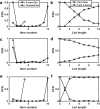Spatiotemporal discrimination in attractor networks with short-term synaptic plasticity
- PMID: 31134433
- PMCID: PMC6571095
- DOI: 10.1007/s10827-019-00717-5
Spatiotemporal discrimination in attractor networks with short-term synaptic plasticity
Abstract
We demonstrate that a randomly connected attractor network with dynamic synapses can discriminate between similar sequences containing multiple stimuli suggesting such networks provide a general basis for neural computations in the brain. The network contains units representing assemblies of pools of neurons, with preferentially strong recurrent excitatory connections rendering each unit bi-stable. Weak interactions between units leads to a multiplicity of attractor states, within which information can persist beyond stimulus offset. When a new stimulus arrives, the prior state of the network impacts the encoding of the incoming information, with short-term synaptic depression ensuring an itinerancy between sets of active units. We assess the ability of such a network to encode the identity of sequences of stimuli, so as to provide a template for sequence recall, or decisions based on accumulation of evidence. Across a range of parameters, such networks produce the primacy (better final encoding of the earliest stimuli) and recency (better final encoding of the latest stimuli) observed in human recall data and can retain the information needed to make a binary choice based on total number of presentations of a specific stimulus. Similarities and differences in the final states of the network produced by different sequences lead to predictions of specific errors that could arise when an animal or human subject generalizes from training data, when the training data comprises a subset of the entire stimulus repertoire. We suggest that such networks can provide the general purpose computational engines needed for us to solve many cognitive tasks.
Keywords: Attractors; Decision-making; Sequence encoding; Synaptic depression.
Conflict of interest statement
The authors declare that they have no conflict of interest.
Figures













Similar articles
-
Stimulus number, duration and intensity encoding in randomly connected attractor networks with synaptic depression.Front Comput Neurosci. 2013 May 9;7:59. doi: 10.3389/fncom.2013.00059. eCollection 2013. Front Comput Neurosci. 2013. PMID: 23675344 Free PMC article.
-
Synaptic plasticity and connectivity requirements to produce stimulus-pair specific responses in recurrent networks of spiking neurons.PLoS Comput Biol. 2011 Feb;7(2):e1001091. doi: 10.1371/journal.pcbi.1001091. Epub 2011 Feb 24. PLoS Comput Biol. 2011. PMID: 21390275 Free PMC article.
-
Fast Learning with Weak Synaptic Plasticity.J Neurosci. 2015 Sep 30;35(39):13351-62. doi: 10.1523/JNEUROSCI.0607-15.2015. J Neurosci. 2015. PMID: 26424883 Free PMC article.
-
Modelling the formation of working memory with networks of integrate-and-fire neurons connected by plastic synapses.J Physiol Paris. 2003 Jul-Nov;97(4-6):659-81. doi: 10.1016/j.jphysparis.2004.01.021. J Physiol Paris. 2003. PMID: 15242673 Review.
-
Networks for memory, perception, and decision-making, and beyond to how the syntax for language might be implemented in the brain.Brain Res. 2015 Sep 24;1621:316-34. doi: 10.1016/j.brainres.2014.09.021. Epub 2014 Sep 18. Brain Res. 2015. PMID: 25239476 Review.
Cited by
-
Multistability in neural systems with random cross-connections.Biol Cybern. 2023 Dec;117(6):485-506. doi: 10.1007/s00422-023-00981-w. Epub 2023 Dec 22. Biol Cybern. 2023. PMID: 38133664 Free PMC article.
-
Co-existence of synaptic plasticity and metastable dynamics in a spiking model of cortical circuits.bioRxiv [Preprint]. 2024 Jun 9:2023.12.07.570692. doi: 10.1101/2023.12.07.570692. bioRxiv. 2024. Update in: PLoS Comput Biol. 2024 Jul 1;20(7):e1012220. doi: 10.1371/journal.pcbi.1012220. PMID: 38106233 Free PMC article. Updated. Preprint.
-
Attractor-state itinerancy in neural circuits with synaptic depression.J Math Neurosci. 2020 Sep 11;10(1):15. doi: 10.1186/s13408-020-00093-w. J Math Neurosci. 2020. PMID: 32915327 Free PMC article.
-
Neural population dynamics of computing with synaptic modulations.Elife. 2023 Feb 23;12:e83035. doi: 10.7554/eLife.83035. Elife. 2023. PMID: 36820526 Free PMC article.
-
Co-existence of synaptic plasticity and metastable dynamics in a spiking model of cortical circuits.PLoS Comput Biol. 2024 Jul 1;20(7):e1012220. doi: 10.1371/journal.pcbi.1012220. eCollection 2024 Jul. PLoS Comput Biol. 2024. PMID: 38950068 Free PMC article.
References
-
- Bathellier B, Ushakova L, Rumpel S. Discrete neocortical dynamics predict behavioral categorization of sounds. Neuron. 2012;76(2):435–449. - PubMed
-
- Brunel N. Dynamics and plasticity of stimulus-selective persistent activity in cortical network models. Cerebral Cortex. 2003;13(11):1151–1161. - PubMed
Publication types
MeSH terms
Grants and funding
LinkOut - more resources
Full Text Sources

